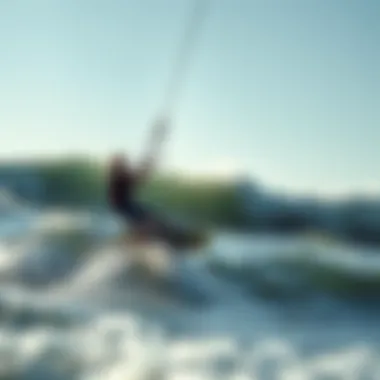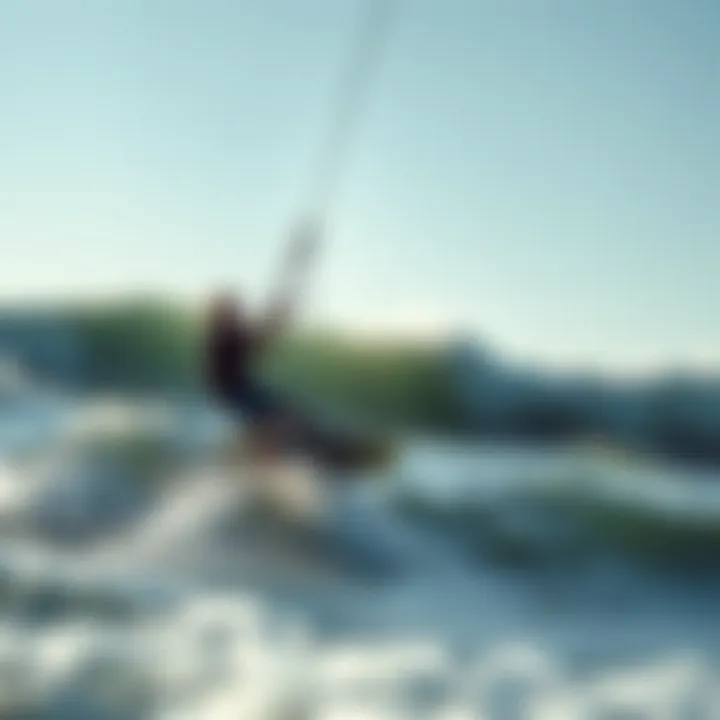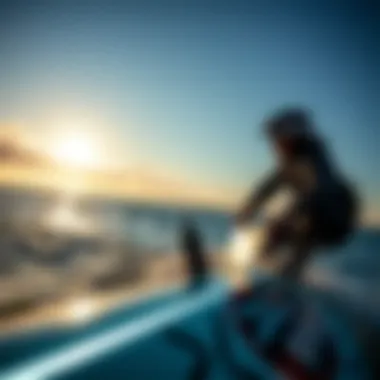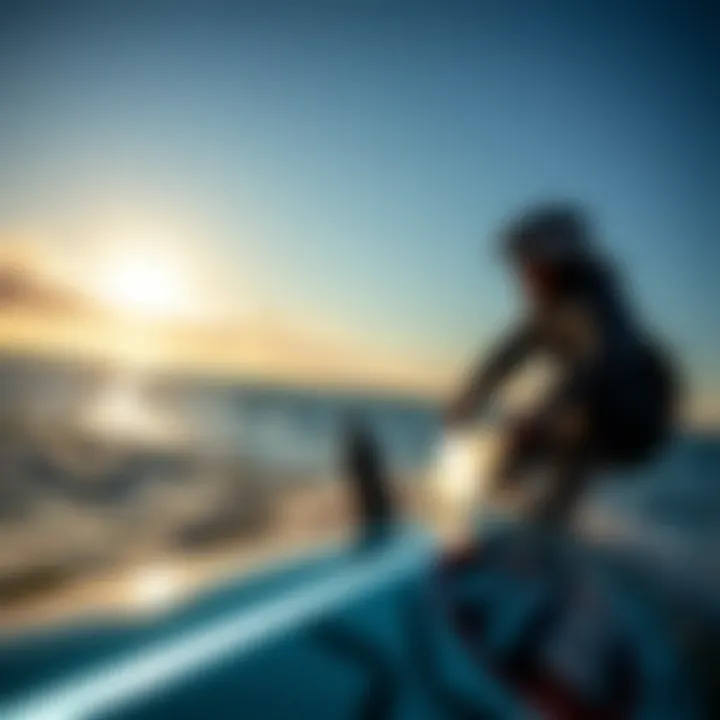Armstrong Foil Insights for Kiteboarding Enthusiasts


Intro
In the realm of kiteboarding, the equipment you choose can make or break your experience on the water. Among the various options, Armstrong foils stand out for their superior design and unmatched performance. This guide takes you through the ins and outs of Armstrong foils—a must-read for both seasoned riders and newcomers looking to ride the waves like never before.
Understanding foiling is key to grasping how kiteboarding and hydrofoils complement each other. At first glance, you might wonder, "What’s so special about Armstrong foils?" Well, this article will break it down for you, focusing on their construction, unique traits, and how they can help you achieve that thrilling gliding experience.
From designs that cater to different styles to insights from expert riders, this comprehensive guide aims to equip you with the knowledge needed to select the right foil for various conditions. Furthermore, tips on maintenance and troubleshooting will ensure your gear remains in top-notch shape, keeping the good times rolling.
So tighten those harness straps and let’s dive into the fascinating world of Armstrong foils.
Prelims to Armstrong Foil
The world of kiteboarding is constantly evolving, and the introduction of specialized gear like the Armstrong foil has significant implications for enhancing performance and riding experience. Armstrong foils offer a unique blend of design advancements that cater to various skill levels and styles. Understanding these foils is essential for anyone looking to elevate their kiteboarding skills, as their structural nuances play a crucial role in how riders interact with the water and the wind.
Familiarizing oneself with the Armstrong foil not only deepens one's appreciation for kiteboarding technology but also equips riders with the knowledge to make informed choices. Whether you're a newbie seeking stability or an experienced kiteboarder in search of speed, the benefits of utilizing the Armstrong foil can markedly alter your approach to the sport.
Historical Background
The Armstrong brand began its journey much like most innovative solutions—fueled by a passion for water sports and a desire to push boundaries. Founded over a decade ago by pioneers who were keen on enhancing performance, Armstrong has evolved from crafting basic foils to producing some of the most advanced models available today.
Early designs often focused on basic hydrofoil metrics, but changes in materials and construction techniques have led to a revolution in kiteboarding equipment. Riders in the early days faced various challenges, most notably related to control and stability. Today, Armstrong's commitment to research and development has resulted in pioneering technologies, allowing riders to fly above the water with unprecedented ease.
The history of Armstrong foils is not just about technological advancements, but also about fostering a community. As they pushed the envelope, the Armstrong team engaged with athletes, gathering feedback which helped refine their designs. Rider recommendations directly influenced development, lending a real-world perspective that continues to guide the brand's evolution.
Current Trends in Foiling
The current landscape of foiling in kitesurfing reveals a noticeable shift towards higher performance standards. Kiteboarders are increasingly seeking technology that enhances speed and responsiveness without sacrificing controllability. Armstrong foils embody this trend, as they are designed to cater to a wide range of sailing conditions.
Key trends influencing the design and adoption of modern foils include:
- Increased Demand for Versatility: Today's riders often engage in multiple styles of kiteboarding. Armstrong has responded by diversifying their range of foils to cater to all-around riders, freestylers, and racers alike.
- Focus on Eco-Friendly Materials: As environmental consciousness rises, the kiteboarding community is more inclined to support brands that prioritize sustainability. Armstrong utilizes eco-friendly materials in their design processes, appealing to the eco-aware rider.
- Technological Integration: More than ever, foils are being equipped with technologies that analyze performance metrics. Riders can now gain insights into efficiency and speed through data-driven approaches, further enhancing their experience.
Understanding the Mechanics of Foiling
Kiteboarding enthusiasts often find that mastering the mechanics of foiling can elevate their experience on the water significantly. Understanding how foils work and grasping the rudiments of hydrodynamics can make the difference between achieving a seamless glide or an exhausting workout. When kiteboarders know their equipment inside out, they open doors to performance enhancement, safety, and overall enjoyment. Let’s delve into each facet critical to understanding foiling mechanics.
How Foils Work
Foils are designed to lift a kiteboarder out of the water, reducing drag and allowing for high-speed maneuvers while keeping you afloat. The magic lies in their shape and angle. Essentially, a foil consists of a mast, a front wing, and a rear stabilizer. When the board begins moving, the angle of attack against the water creates lift. The air pressure below the wing is greater than the pressure above, enabling the board to rise above the surface. This lift enables riders to skim across the water, transforming the experience.
The key elements to consider about how foils operate include:
- Wing Shape: Different shapes can produce varying lift and drag characteristics. Wider wings cater to beginners, offering stability but may be slower. Conversely, more tapered wings are for advanced riders, enhancing speed.
- Angle of Attack: Adjusting the angle of the wing can be advantageous depending on the conditions. A higher angle may increase lift but can also raise drag, impacting performance.
- Size Matters: Larger foils provide more lift at lower speeds, whereas smaller foils enable higher speeds but require more momentum to achieve lift.
In summary, the interplay of these elements plays a crucial role in a rider’s ability to control speed and maneuverability on the water.
Hydrodynamics Basics
Understanding the fundamentals of hydrodynamics is like knowing the rules of the game in kiteboarding. It’s essential for ensuring that you harness your foils effectively. The principles of hydrodynamics govern how forces interact between the water and your foil.
- Lift and Drag: As mentioned earlier, lift is generated by the differences in pressure on either side of the wing. However, drag is the resisting force you must contend with, slowing you down. Apprentices of foiling learn to balance these two forces, which can lead to more efficient riding.
- Fluid Flow: Water flows over the wing and mast. The smoother and faster this flow, the less drag you experience. Undoubtedly, your foil's design influences how it interacts with water.
- Pressure Variations: Changes in speed and pitch affect how pressure is distributed across your foil, leading to different outcomes in stability and lift.
To sum it up, a solid grasp on hydrodynamics can significantly affect performance. Riders who pay attention to these concepts are likely to find improvements in their foiling skills, as they learn to blend speed with style on the water.
"Understanding how hydrodynamics plays a role in foiling can provide riders with that competitive edge they need in various conditions."
In the realm of kiteboarding, the mechanics of foiling are more than just a technical component; they form the very foundation of your daily adventures on the water.
Armstrong Foil Design and Features
When it comes to kiteboarding, the design and features of the Armstrong foil play a crucial role in the performance and experience of the rider. Every element, from materials to the wing's shape, has been meticulously engineered for not just optimal performance but also for durability and adaptability in various conditions. Understanding these facets helps both novices and seasoned kiteboarders make informed decisions, ensuring they select the right piece of equipment that aligns with their riding style and environmental conditions.
Material Choices
Choosing the right material is fundamental to the performance of Armstrong foils. Advanced materials such as carbon fiber and aluminum are often favored due to their unique properties.


- Carbon Fiber: This lightweight material offers high stiffness and strength, crucial for maintaining integrity under stress while reducing overall weight. While it can be pricier, the performance benefits can outweigh the costs in many cases.
- Aluminum: More budget-friendly, aluminum foils can be quite durable. While they might be heavier than carbon fiber, they still provide a solid performance for beginners or those looking to ride more casually.
- Composite Materials: In some cases, a blend of materials is utilized to strike a balance between weight, cost, and performance. This kind of innovative thinking in design often defines Armstrong's reputation in the market.
Ultimately, the choice of material may depend on the rider's preferences, budget, and the specific riding conditions they anticipate encountering.
Wing Size and Shape
The wing size and shape significantly affect lift, speed, and maneuverability in foiling. Armstrong takes pride in offering a variety of wing options that cater to different styles and conditions.
- Surface Area: A larger wing surface area generally provides more lift but may sacrifice speed and maneuverability. This makes them preferable for beginners or those in lighter winds.
- Aspect Ratio: The ratio of the wing's span to its chord width also plays a vital role. Higher aspect ratios tend to increase speed and efficiency, making them suitable for racing or advanced riders. Meanwhile, lower aspect ratio wings may be more forgiving and easier to control, making them ideal for freestyle maneuvers.
- Wing Shape: The design of the wing, such as whether it’s flat or curved, influences how water flows over it during rides. Curved wings typically handle better and offer a smoother ride, enabling riders to maintain control even under shifting winds.
In summary, the wing's size and shape must align with the rider's skill level and desired performance outcomes.
Stabilizers and Fuselage
Stabilizers and the fuselage are essential components that enhance stability and control while foiling. They ensure that the foil behaves predictably in various conditions.
- Stabilizers: These are smaller wings located at the rear of the foil. They help maintain balance and assist in preventing tail dives. For kiteboarders looking for stability during maneuvers or while tackling choppy waters, selecting an appropriate stabilizer is key.
- Fuselage: The fuselage connects the mast to the wings. The length and rigidity of the fuselage can affect how a foil balances and turns. Shorter fuselages can enhance maneuverability but may reduce overall stability, while longer ones provide steadiness but can mask responsiveness.
When selecting stabilizers and fuselage configurations, consider your riding style and the environments you plan to shred in.
"The magic of foiling comes not just from the wings but how every element interacts to create an exhilarating ride through water."
Through understanding these design aspects—material choices, wing profiles, and stabilizers—it becomes clear how Armstrong foils set themselves apart in kiteboarding. By thoroughly analyzing these specifications, riders can optimize their experience on the water, gaining an edge in skills development and performance.
Types of Armstrong Foils
Understanding the different types of Armstrong foils is crucial for kiteboarding enthusiasts aiming to optimize their riding experiences. Each foil type caters to specific styles, conditions, and rider levels, making the proper choice paramount. Selecting the right foil can greatly enhance performance, control, and overall enjoyment on the water. Here, we explore the three main categories of Armstrong foils: All-Around, Freestyle, and Race. Each type boasts unique features tailored to meet diverse riding preferences and conditions.
All-Around Foils
All-around foils are designed for versatility, making them suitable for various conditions and skill levels. They tend to offer a balance between lift, speed, and stability. For riders who might experience changing wind conditions or who want to enjoy different styles of riding, all-around foils make the perfect choice.
- Stability: This type of foil provides dependable stability, allowing beginners to build confidence while also fulfilling the demands of more advanced riders.
- Ease of Use: Many riders appreciate the uncomplicated nature of all-around foils. They typically wield a user-friendly design that makes it easy to learn and master.
- Performance in Varied Conditions: Riders can use all-around foils in light winds, choppy water, and even while practicing tricks. They perform reliably across diverse environments.
"All-around foils are like a Swiss Army knife for kiteboarders - adaptable and ready for anything."
Freestyle Foils
Freestyle foils take center stage when it comes to performing acrobatics and tricks on the water. They are engineered with specific characteristics that help riders execute jumps, spins, and other complex maneuvers.
- Flexibility: These foils usually feature a slight flex, which allows for dynamic movements and adjustments during jumps.
- Lift and Speed: A higher aspect ratio coupled with a smaller wing area provides heightened lift and speed, essential for executing tricks.
- Specialized Shape: The design of freestyle foils allows for sharp turns and rapid transitions, increasing the opportunity for creative riding.
Race Foils
Race foils represent the pinnacle of performance and efficiency in kiteboarding. Designed for speed, they are favored by competitive riders who seek to push the boundaries of what is possible on the water.
- High Aspect Ratio: This leads to reduced drag and enhanced speed potential, making them ideal for competitive racing environments.
- Precision and Control: Race foils offer precise handling, allowing seasoned riders to optimize their racing techniques.
- Materials and Build Quality: Typically constructed from lightweight, high-performance materials, race foils are built for durability and efficiency despite being feather-light.
Advantages of Using Armstrong Foils
In the ever-evolving world of kiteboarding, Armstrong foils have carved a niche for themselves, standing out for their unique design and exceptional performance. These foils are not just any gear; they play a pivotal role in enhancing the riding experience. Understanding the advantages of using Armstrong foils can help kiteboarders make informed decisions, ensuring they get the most out of their sessions on the water.
Enhanced Performance in Various Conditions
One of the most prominent features of Armstrong foils is their ability to perform consistently well across different water conditions. Whether you're riding on choppy seas or smooth lakes, these foils adapt seamlessly. High-quality materials and innovative design ensure less drag and optimal lift, resulting in a more stable ride. For instance, kiteboarders often praise Armstrong foils for their impressive ability to handle gusty winds without compromising on control. This versatility allows riders to venture into various environments, expanding their options for kiteboarding locations.
"Riding with an Armstrong foil feels like flying above the water, even when conditions are not perfect. It gives me confidence to explore new spots." – A passionate kiteboarder.
Stability and Control
The stability offered by Armstrong foils is remarkable. They provide a feeling of confidence that riders crave, especially when tackling waves or strong currents. This stability is a product of precise engineering, including the geometry of the wings and the fuselage design. The combination of these elements results in a foil that stays grounded, minimizing the chances of an unwanted crash. Moreover, advanced stabilizers enhance the overall control, allowing riders to execute tricks or transitions smoothly. With Armstrong foils, even those still mastering their skills can find greater ease in navigating tricky situations, fostering a positive learning environment.
Efficiency and Speed
Armstrong foils are not just about stability; they excel in promoting efficiency and speed. The construction of these foils is such that they glide smoothly through the water, requiring less effort from the rider. This efficiency translates into longer rides and reduces fatigue, making it an excellent choice for those looking to maximize their time on the water. Riders often report being able to reach higher speeds without feeling worn out, which is crucial for both thrill-seekers and those who enjoy a leisurely ride. With a well-chosen Armstrong foil, kiteboarders can push their limits, whether they are racing against friends or cruising along the shoreline.


Choosing the Right Armstrong Foil
Selecting an Armstrong foil isn't just about picking what looks good on the rack; it’s a decision that can greatly impact your kiteboarding experience. Each foil caters to different skill levels, riding styles, and environmental conditions. Making an informed choice not only enhances your enjoyment but also helps you progress faster.
Assessing Skill Level
Before you dive into the vast ocean of foils, it's crucial to take a step back and evaluate your skill level. Beginners might want to start with a more forgiving design that emphasizes stability and ease of use. For instance, a larger wing size can create more lift, making it easier to get on the foil without a lot of practice.
A good starting point is a foil like the Armstrong HS 1050, which is known for its gentle lift and wide windrange. On the other hand, advanced riders may lean towards smaller wings designed for speed and agility. Here, a foil such as the Armstrong HA 925 might be more appealing. It's swift and responsive but requires a higher skill level to manipulate effectively.
Understanding where you fit in the skill spectrum helps inform your selection. If you’re not really sure, consider borrowing or renting different models before making a commitment. This way, you can find what really resonates with your riding style.
Riding Style Considerations
Riding style plays a significant role in the kind of foil you choose. Whether you fancy cruising, freestyle tricks, or high-speed racing, Armstrong has options crafted specifically for those preferences. Each type of foil caters to the nuances of various riding styles.
- All-Around Foils: Perfect for those who enjoy mixing tricks with casual cruising. These foils provide a good balance between speed and performance.
- Freestyle Foils: Designed for taking jumps and performing tricks. They offer a lot of lift and are generally stiffer to give you that extra pop.
- Race Foils: Precision and speed are the names of the game here. They typically have a thinner profile for reducing drag and maximizing performance on the racecourse.
When selecting a foil, think carefully about how you like to ride. Do you want to carve like a knife through butter or fly high like a kite? Each foil will give you a different capability to perform those moves.
Environmental Factors
Lastly, environmental conditions can't be overlooked when making this choice. Understanding the specific conditions in which you’ll be riding can significantly affect your experience. Think about factors like wind strength, water type, and your local climate.
- Wind Strength: If you often find yourself in light wind areas, you might want to select a foil with a larger surface area. Conversely, for high wind conditions, a smaller, more compact design would allow for better maneuverability.
- Water Type: Choppy water, flat water, or small waves all demand different foil designs. A foil that excels in flat water may struggle in choppy conditions and vice versa.
- Climate: Warm water might make a more sensitive foil feel less forgiving, whereas cold water may call for a foil that can withstand harsher treatments.
Adapting your equipment to best suit your environment is a surefire way to maximize enjoyment on the water.
Remember, there’s no one-size-fits-all when it comes to choosing the right Armstrong foil. Each choice can open up new adventures or limit your potential.
Finding the right Lfoil means considering skill level, riding style, and environmental conditions all together to ensure you hit the waves just right.
If you're interested in diving deeper into these considerations or different models, resources like Wikipedia, Britannica, and community discussions on Reddit can be valuable for further exploration.
Maintenance of Armstrong Foils
Taking care of your Armstrong foils is crucial for achieving peak performance and longevity on the water. Neglecting maintenance can lead to deterioration, affecting not only the foil's capabilities but also your overall kiteboarding experience. Just like any fine piece of equipment, regular upkeep is essential. This section will walk through the intricacies of maintaining your foils, providing actionable insights for both new and seasoned riders.
Cleaning Procedures
Cleaning your Armstrong foils seems straightforward, but it is often overlooked by many kiteboarders, especially after a long day on the water. Saltwater, sand, and debris can accumulate on your gear, leading to potential damage and reduced performance. Here’s a concise guide to the cleaning process:
- Freshwater Rinse: After every session, rinse your foils thoroughly with freshwater. This simple step dislodges salt and sand particles that can wear down your equipment over time.
- Use a Soft Cloth: Employ a soft cloth to wipe down the foil's surfaces, particularly the wings and fuselage. Avoid abrasive materials that might scratch or damage the finish.
- Inspect for Damage: While cleaning, take the opportunity to inspect for cracks, dings, or other imperfections. If you spot any, address them promptly before they worsen.
"Regular cleaning is like fuel for your performance; skip it, and you'll find yourself limping along the water."
- Drying: Ensure your foil is completely dry before storing it. This helps to prevent mold and corrosion, especially on metal components.
By following these basic cleaning procedures, you can enhance the lifespan of your Armstrong foils, allowing you to keep riding the waves much longer.
Storage Tips
Proper storage of your Armstrong foils is just as important as the cleaning process. Without correct storage, even the best-designed foils may suffer damage and degrade over time. Here are practical tips to consider:
- Temperature Control: Store your foils in a climate-controlled area, away from extreme heat or cold. Excessive temperatures can warp the material and impair performance.
- Avoid Direct Sunlight: UV rays can degrade foils, leading to reduced lifespan. Use a bag or cover to keep them protected from prolonged sun exposure.
- Keep It Upright: When storing, position your foils upright rather than lying flat. This reduces pressure on the wings and prevents warping.
- Separate Components: If possible, separate wings, fuselages, and stabilizers during storage. This prevents scratches or damage that may occur when components are packed tightly together.
By adhering to these storage practices, you can safeguard your investment and ensure that your Armstrong foils remain in top-notch condition for every ride.
User Experiences and Testimonials
Understanding the real-world experiences of users is crucial when analyzing products like Armstrong foils. Feedback from kiteboarders reveals insights drawn from the waters, encompassing not only performance but also emotional connections and personal achievements made possible by these foils. This section gathers authentic accounts that highlight various aspects such as speed, stability, and ease of use.
User testimonials can serve as a goldmine of information. They not only help prospective buyers gauge the product's worth but also offer a connection to the community. Each voice contributes to a larger narrative about the brand and its effectiveness. Considerations such as personal riding styles, local conditions, and individual skill levels play into these testimonials, making them invaluable for those looking to make informed choices.
"The best recommendation comes from those who have been there, done that; user experiences paint a vivid picture of what to expect."


Beginners' Insights
For those just kicking off their journey in kiteboarding, user experiences often highlight the importance of comfort and stability. Many newcomers find themselves overwhelmed by the range of equipment choices. However, Armstrong foils often come recommended for their user-friendly design.
New riders frequently stress the need for an easy transition from ground to water and feedback suggests that Armstrong foils excel in this area. Beginners tend to appreciate the following:
- Lightweight design: New riders often mention how the light materials make handling easier.
- Stability: Comments on maintaining balance and avoiding a steep learning curve can be common. Riders frequently describe how Armstrong’s stability aids their confidence on the water.
- Versatility: Many new kiteboarders enjoy using foils suitable for various conditions without needing to constantly switch equipment.
In essence, novices express feelings of empowerment when they can ride without excessive difficulty, and Armstrong foils seem to provide that initial boost.
Advanced Riders' Perspectives
In contrast, seasoned kiteboarders are more likely to focus on performance nuances and technical aspects. Advanced users actively search for efficiency and speed, and reviews often reflect a deeper understanding of hydrodynamics.
From discussions in forums to feedback collected from competitions, seasoned riders highlight:
- Speed capabilities: Testimonials reveal that the Armstrong foils allow for swift maneuvers and improved glide, which is essential during racing or freestyle sessions.
- Customizability: Advanced users frequently appreciate the range of wing shapes and sizes that can be mixed and matched to optimize performance.
- Durability: Many experienced riders mention how the materials hold up when pushed to their limits, especially in demanding environments.
Some advanced kiteboarders also share that using Armstrong foils has helped them discover new riding techniques. They consider it an invaluable tool for personal growth, enabling them to experiment and innovate on the water.
In summary, both beginners and advanced riders showcase their unique journeys while using the Armstrong foils. Their experiences not only underline the performance and usability of the product but also contribute to the evolving narrative of kiteboarding as a sport where shared knowledge and personal progression play significant roles.
Comparative Analysis with Other Foils
When it comes to kiteboarding, selecting the right foil can mean the difference between a lackluster session and one that leaves you buzzing with excitement. This section dives into Comparative Analysis with Other Foils, a crucial aspect of understanding how Armstrong foils stack up against their rivals. It’s not just about what’s new and shiny; it’s about finding the perfect match for your unique riding style and conditions.
Armstrong vs. Competitors
In the world of foiling, Armstrong has made a name for itself with high-quality designs and performance. But how do these designs hold up against competitors in the marketplace?
- Build Quality: Armstrong foils are known for their robust construction, often utilizing materials like carbon for lightness and strength, giving them an edge in durability. In contrast, while some competitors might use simpler aluminum, they may not offer the same level of weight savings.
- Stability: Riders often rave about the stability provided by Armstrong foils, even in choppy conditions. Competitors such as Naish or Slingshot may offer decent alternatives, but the feedback isn't always as favorable regarding performance in rough waters.
- Customization Options: Armstrong offers various wing configurations to suit different riding styles. This flexibility isn't always matched by other brands, which might focus on specific setups without the ability to customize to the same extent.
When considering an investment in foils, each rider’s priorities will differ, whether that be performance, stability, or versatility. Comparing these attributes clearly outlines Armstrong's competitive strengths and weaknesses.
Performance Metrics Comparison
Charts and graphs can only tell you so much; the real judge is how a foil feels while riding it. But to understand how Armstrong fares, a performance metrics comparison is essential.
- Speed: Armstrong foils often report faster average speeds in comparisons, particularly in flat water. A focus on hydrodynamic design leads to less drag and greater lift.
- Maneuverability: Riders will notice the difference when turning. Armstrong's design philosophy tends to favor agility, allowing for quicker pivots compared to some other brands that may feel sluggish at high speeds.
- Lift-to-Drag Ratio: This key metric is where Armstrong shines, as it often provides superior lift without excessive drag, translating to a smoother surf experience.
For any kiteboarder aiming to elevate their performance, understanding these metrics and how they relate to personal needs can assist in making a very informed decision.
"The best foil is the one that fits your style and conditions perfectly—never forget to consider what you prioritize most."
In summary, this comparative analysis reveals much about Armstrong foils in relation to the competition, highlighting not just where it excels, but also where there may be room for improvement. Individual preferences matter greatly, shaping the experience every kiteboarder hopes to achieve on the water.
For a deeper dive into foiling technology, you can check out various resources: Wikipedia and Britannica.
Future of Foiling in Kiteboarding
As kiteboarding continues to gain traction around the globe, the future of foiling is shaping up to be quite thrilling. The sport is rapidly evolving, and it's crucial for enthusiasts to stay abreast of upcoming trends and technologies. The advancements in foiling technology are not just about improving performance; they also bring new dimensions to the sport, making it more accessible for newcomers while challenging seasoned riders. With that in mind, let’s discuss some key elements that define this promising future.
Technological Innovations
Technological advancements are at the core of the evolution of foiling in kiteboarding. Leading manufacturers, including Armstrong, are integrating cutting-edge materials and designs to enhance the craft's performance on water. For instance, the use of carbon fiber has surged due to its lightweight properties and strength. Riders benefit from increased speed and reduced fatigue during longer sessions out on the water.
Moreover, smart technology is making its way into the kiteboarding realm. Foils equipped with sensors to monitor performance metrics such as speed, altitude, and angle of attack provide users with valuable data. This information could help in tuning setups according to riding style and conditions, ultimately enhancing the entire kiteboarding experience.
Another exciting development is the application of 3D printing in creating custom parts for foils. This allows for personalized designs that meet individual needs, something traditional manufacturing processes can't easily replicate. Such innovations empower riders, giving them more creative freedom and flexibility, while also reducing production costs.
"The future of kiteboarding isn’t just about riding; it's about customizing and optimizing each session with new tech."
Evolving Riding Techniques
As the technology behind foiling advances, so too do the techniques utilized by riders. New methods are continuously being explored, often blending traditional riding styles with innovative approaches. The influence of trick-oriented styles from freestyle kiteboarding is becoming increasingly apparent. Riders are experimenting with pitch, roll, and yaw to achieve new feats on the foil that were once thought impossible.
In essence, learning to foil effectively now encompasses a more holistic understanding of one’s equipment. Riders are increasingly focusing on not just what their gear can do, but how their own riding technique needs to adapt accordingly. This evolution introduces an intriguing challenge; kiteboarders must master the fine line between power and finesse to excel.
As more kiteboarders embrace these shifts, we can expect to see a broader spectrum of riding styles emerging, alongside competitions that celebrate innovation both in tech and technique. The community flourishes when riders share tricks and tips, pushing each other toward greater heights (sometimes literally!).
In summary, the future of foiling in kiteboarding is brimming with potential. With technological innovations pushing the envelope of performance and evolving riding techniques inviting more creativity, kiteboarding enthusiasts are in for an exciting journey ahead.















